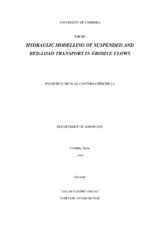Mostrar el registro sencillo del ítem
Hydraulic modelling of suspended and bed-load transport in erosive flows
| dc.contributor.advisor | Castro Orgaz, Óscar | |
| dc.contributor.advisor | Ayuso-Muñoz, J.L. | |
| dc.contributor.author | Cantero Chinchilla, Francisco Nicolás | |
| dc.date.accessioned | 2016-10-05T09:24:03Z | |
| dc.date.available | 2016-10-05T09:24:03Z | |
| dc.date.issued | 2016 | |
| dc.identifier.uri | http://hdl.handle.net/10396/13878 | |
| dc.description.abstract | Depth-averaged modelling of river flows is a widely used technique in hydraulic engineering, given the reduced computational work as compared to a three dimensional numerical solution. Typically, depth-averaged models rely on the assumptions of a hydrostatic pressure distribution, and depth-independent velocity and concentration distributions. However, even though Saint-Venant type models produce good results for the solution of a wide range of engineering problems, a significant increase in accuracy is achieved by using more realistic assumptions for the vertical structure of the flow. The main objective of this thesis is to study the effect of higher-order closure hypothesis for the vertical distributions of pressure, velocity and concentration, on the solution of one-dimensional depth-averaged models for river flow problems. This main objective is developed in the following specific studies: (i) The effect of the non-hydrostatic pressure distribution is first investigated in a basic section of river flow, namely the compound channel. Here, the energy and momentum balances in steady-state are investigated; (ii) Unsteadiness is introduced using the dam break flood wave over a rigid bed as a test case. Here, the accuracy of the velocity and pressure distributions of Serre-type, depth-averaged, non-hydrostatic flows is assessed; (iii) The finite-volume numerical model developed for dam break waves over rigid beds is expanded to dam break wave flows over movable beds by introducing a non-equilibrium sediment transport model, and the suspended sediment flux; (iv) An analytical solution for the equilibrium suspended-load flux is proposed used a power-law for the turbulent velocity profile, and a wall-wake concentration profile; (v) The effect of highly non-uniform distributions of velocity and concentration is investigated introducing a similarity approximation for erosive/depositionalflows in turbidity currents. | es_ES |
| dc.format.mimetype | application/pdf | es_ES |
| dc.language.iso | eng | es_ES |
| dc.publisher | Universidad de Córdoba, UCOPress | es_ES |
| dc.rights | https://creativecommons.org/licenses/by-nc-nd/4.0/ | es_ES |
| dc.subject | Ingeniería hidráulica | es_ES |
| dc.subject | Hidráulica fluvial | es_ES |
| dc.subject | Modelado hidráulico | es_ES |
| dc.subject | Flujos biogeoquímicos | es_ES |
| dc.subject | Ríos | es_ES |
| dc.subject | Hydraulic engineering | es_ES |
| dc.subject | Fluvial hydraulics | es_ES |
| dc.subject | Hydraulic modelling | es_ES |
| dc.subject | Rivers | es_ES |
| dc.title | Hydraulic modelling of suspended and bed-load transport in erosive flows | en |
| dc.type | info:eu-repo/semantics/doctoralThesis | es_ES |
| dc.rights.accessRights | info:eu-repo/semantics/openAccess | es_ES |

